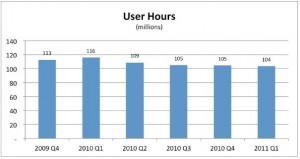The latest issue of the Journal of Virtual Worlds Research has been out for a few weeks now, and I’ve been meaning to posts a synopsis, so here’s exactly that for  the peer-reviewed articles in Volume 3, No.3, with some horribly abbreviated summaries of findings for those too lazy to read the articles or the abstracts themselves.
 Synthesizing Presence: A Multidisciplinary Review of the Literature
 A detailed cross-discipline review of research on presence. 97 citations were found across Mass Communnications, Human-Computer Interfaces, Education and Psychology. Findings: there are very different perspectives on the issue depnding on the discipline and that an agreed framework for understanding the area is needed to move forward.
A very interesting look at how one effectively captures user-to-user communications in a virtual world environment. There’s a focus on establishing accuracy and three methods of collecting data are assessed within a Japanese MMO, Uncharted Waters Online. Findings: All three approaches explored are statistically viable and the choice of method depends on the individual research.
 A detailed look at a Second Life-based health initiative tackling obesity. An in-world exercise program, health information and social support was provided with promising outcomes. Challenges and opportunities of the approach are outlined. Findings: Good participation occurred, there were challenges in recruitment and retention and technical hurdles with Second Life were a barrier to a number of potential participants. Further research is recommended on optimal in-world exercise programs to deliver physical world results.
———-
Aside from those three articles, there’s a group of research papers:
 Design Principles for Doing Business on Second Life: an immersive ethnographic study
Methodology of a Novel Virtual Phenomenology Interview Technique
It’s fair to say that the research being undertaken continues to grow, although I remain a little concerned at the level of research demonstrating detailed qualitative or quantitative outcomes. It’s happening, but unfortunately at this stage the industry is still very fragmented and disseminating that information is challenging. Journals like the JVWR are obviously helping in that regard.









Recent Comments